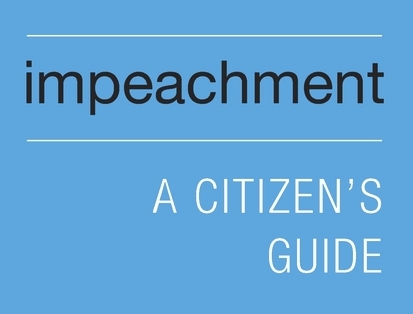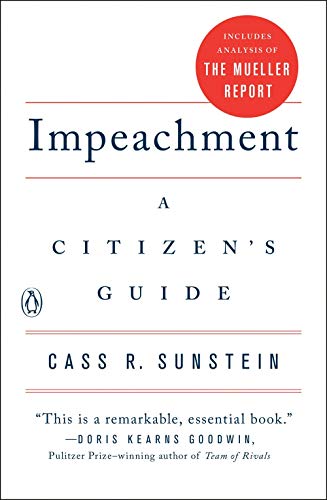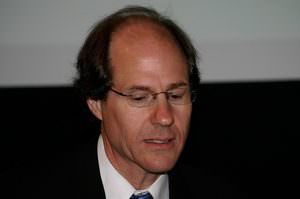Impeachment: A Citizen’s Guide
Harvard Law professor Cass Sunstein has written a concise, enlightening and argumentative outline for getting rid of presidents. Harvard University Press
Harvard University Press
“Impeachment: A Citizen’s Guide” A book by Cass Sunstein
Hey, let’s talk about impeachment. You know, just in case it ever comes up.
Harvard law professor Cass Sunstein has written a concise, enlightening and argumentative history and guide to getting rid of presidents, but he insists he is not thinking of anyone in particular. Or, more accurately, he won’t tell us if he’s thinking of anyone in particular. “With the goal of neutrality in mind,” Sunstein writes in his opening chapter, “I am not going to speak of any current political figure. I am going to focus on the majesty, and the mystery, of impeachment under the U.S. Constitution.”
I’m not convinced that, under different political circumstances, we’d be seeing many new how-to books on the meaning and mechanics of presidential impeachment. (Indeed, Sunstein’s is not even the only one with this title.) But let’s take the author at his word and avoid naming names. For the moment, we can allow majesty to trump specificity.
And describing “Impeachment: A Citizen’s Guide” as a how-to book is not quite accurate, in any case. It’s more of a why-to and when-to, and a what-were-they-thinking-when-they-decided-to kind of book. Sunstein delves into the writings, speeches and deliberations of America’s revolutionary generation and concludes that impeachment was at the core of the founders’ effort to “balance the defining republican commitments to liberty, equality, and self-rule with the belief in a strong, energetic national government.”
Click here to read long excerpts from “Impeachment” at Google Books.
America, especially in the post-Articles of Confederation period, needed a strong executive but feared one as well. The solution, Sunstein writes, was “a chain with three links: a single magistrate; election every four years; and impeachment.”
Sunstein draws heavily on the deliberations of James Madison and Alexander Hamilton—I mean, why wouldn’t you—to explain the case for impeachment and its constitutional role. A president “might pervert his administration into a scheme of peculation or oppression,” Madison worried, for instance. “He might betray his trust to foreign powers.” But it is George Mason who delivers perhaps the most eloquent and memorable case for the people’s right to impeach their highest elected leader: “Shall any man be above Justice? Above all, shall that man be above it, who can commit the most extensive injustice? … Shall the man who has practiced corruption & by that means procured his appointment in the first instance, be suffered to escape punishment, by repeating his guilt?”
More recently, high elected officials have delivered their own definitions and rationales. In 1970, Gerald Ford, then a member of Congress, described an impeachable offense as whatever a majority of the House of Representatives believes it to be “at a given moment in history.” And House Minority Leader Nancy Pelosi asserted this year that a president cannot be impeached unless he has broken the law.
“Both Ford and Pelosi got it fundamentally wrong,” Sunstein writes. “Their views make a mockery of the constitutional design.”
Based on his close reading of the founders and constitutional law, Sunstein notes, impeachment is a remedy available only “for egregious abuses of official authority.” It is in a president’s discharge of the duties of that office—or in the acquisition of the office—that impeachable offenses can occur. So criminal behavior is neither necessary nor sufficient to trigger impeachment. So while a crime is not absolutely necessary for impeachment, it is not sufficient to trigger impeachment, either. Sunstein binds impeachment to the revolutionary aims of the founders. “A violation of liberty or rights is an impeachable offense—even if it is not itself a crime.”
You don’t have to be an originalist to accept that the founders’ vision of impeachment remains entirely relevant. “Sure, the president is far more powerful, and sure, he can commit ‘misdemeanors’ that the founding generation could not have imagined,” Sunstein writes. “But the abstract concerns that motivated them—treason, bribery, corruption, egregious abuse of public trust or misuse of presidential authority—are no different from those that concern us.”
Sunstein continues this book—which, don’t forget, is absolutely not at all about any current politician—by considering scenarios that should or should not trigger impeachment. Just suppose, for instance, that a president “has admiration and sympathy for a foreign nation that wishes to do harm to the United States … [and] reveals classified information to leaders of that nation,” Sunstein posits. Or assume that a president really loves police officers, believes they are unfairly accused of murder and assault, and one day promises to pardon any one of them charged with such crimes. Or picture, if you can, a president who “lies, constantly and on important occasions, to the American people” regarding all manner of issues, in a repeated and egregious fashion. “We could also imagine,” Sunstein writes, “a truly bizarre political context, in which a sitting president is destroying his own party’s prospects, or in which his decisions seem, even to his own people, to be so damaging and eccentric that he has to be relieved of his duties.” In all such cases, he concludes, impeachment can and should be an option.
But say, for instance, that a president is revealed to have cheated on his taxes before taking office or even after. Those are not impeachable offenses, even if they end up being criminal ones, Sunstein contends, because they did not involve a misuse or abuse of his official powers. Or imagine, if you possibly can, a president who constantly displays terrible judgment and makes erratic decisions that “lead to domestic and international turmoil.” That would not be impeachable, either. Simply being a bad—or even failed—president is plenty enough to cost you re-election, but not enough to launch impeachment proceedings.
Sunstein returns again and again to what the Constitutional Convention was trying to accomplish with impeachment. “The delegates who supported the power to impeach and remove the president wanted to thread a needle,” he writes. “They sought to create a safety valve while also maintaining the separation of powers and ensuring that the president would not be Congress’ lackey.”
The power of impeachment can itself be abused, Sunstein argues, pointing to the two presidential impeachments on the books thus far. Andrew Johnson was impeached in 1868 for firing his secretary of war and thus violating the Tenure of Office Act—a law that had been passed precisely to bait the president into an impeachable offense. And Bill Clinton was impeached during his second term, accused of perjury and obstruction of justice relating to his relationship with Monica Lewinsky and a lawsuit by Paula Jones. Even if the president acted unlawfully, Sunstein writes, the situation should not have risen to the level of impeachment because it did not involve an egregious abuse of the office. “It is not impeachable to use official power to cover up an action that is not itself impeachable,” Sunstein writes. In both cases, the presidents were acquitted by the full Senate. And Richard Nixon, far more deserving of impeachment than the other two, never suffered the fate because his resignation pre-empted it.
For all his scholarly and historical excavations, Sunstein admits that impeachment has traditionally been a partisan affair. Democrats are more likely to support impeachment of Republicans and vice versa, while all politicians are less inclined to impeach presidents of their own parties. The author looks at modern politics and worries that extreme partisanship, the easy spread of false information, and various behavioral and psychological traps such as group polarization and confirmation bias—you know Sunstein’s gonna Sunstein—“will result in unjustified, harmful and destabilizing efforts” to impeach presidents.
He is also concerned, to be fair, that our elected representatives won’t use the power when they should, perhaps fearing the reaction by the president’s supporters. “If a president systematically overreaches in his use of executive authority, or puts civil rights and civil liberties seriously at risk, he is likely to have, or to be able to get, the backing of a lot of Americans—at the very least, a big chunk of the electorate,” Sunstein reasons. “Will We the People end up doing anything in response? I don’t know.”
Does he think we might face such a dilemma in the near future? This book doesn’t say so—remember, majesty and all that. But there might be a clue in Sunstein’s next book, an essay anthology forthcoming in March. Its title: “Can It Happen Here? Authoritarianism in America.”
I wonder if that one is also about no one in particular. ___
Carlos Lozada is associate editor and nonfiction book critic of The Washington Post. ©2017, The Washington Post
Your support is crucial…With an uncertain future and a new administration casting doubt on press freedoms, the danger is clear: The truth is at risk.
Now is the time to give. Your tax-deductible support allows us to dig deeper, delivering fearless investigative reporting and analysis that exposes what’s really happening — without compromise.
Stand with our courageous journalists. Donate today to protect a free press, uphold democracy and unearth untold stories.






You need to be a supporter to comment.
There are currently no responses to this article.
Be the first to respond.